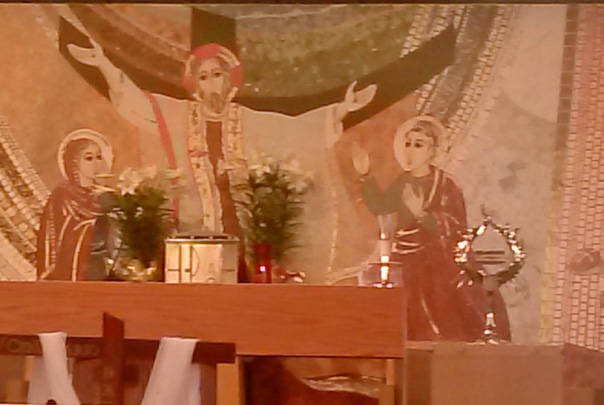Most Catholics refer to their "Sunday Obligation" as Mass, which is derived from the dismissory exhortation "Ite, missa ist" (Latin for "Go forth, the mass has ended"). Eastern rite Christians (as well as the Orthodox Christians) refer to their worship as "the Divine Liturgy". The etymology of liturgy is from the Greek meaning "public service". It may surprise some Roman Catholics that they celebrate two liturgies in a Mass-- the Liturgy of the Word (when scripture is read) and the Liturgy of the Eucharist (when the sacrament of the Eucharist is sanctified).
As someone who cares about good liturgy (or is deemed a liturgy snob), it begs the question-- What is good liturgy? For me, good liturgy can be achieved in many ways.
As someone who cares about good liturgy (or is deemed a liturgy snob), it begs the question-- What is good liturgy? For me, good liturgy can be achieved in many ways.
Some revel in the
majesty of the Tridentine Mass (the traditional "Latin Mass" instituted by Pope Pius V in 1570). Yes,
that can be beautiful, as I experienced for the funeral of March for Life founder Nellie Gray.
 |
| Nellie Gray Funeral at St. Mary's Church, Washington DC 24 August 2012 [photo: BD Matt] |
But a low Mass rapidly mumbled by a curate
who barely knows Latin is not. While I
endorse the Extraordinary Form as an option, I do not consider it the Alpha and
the Omega of good liturgy. I have no issues with a Novus Ordo liturgy (sometimes known as the Mass of Pope Paul VI from 1970), but I do not feel drawn to worship that way every week.
As a Vatican II
baby, I do not automatically recoil when I hear the sound of guitars coming
from the choir. I readily attest that I
have often enjoyed worshipping with the
People of God in the pews as we
enthusiastically sang hymns by the St. Louis Jesuits. But I have cringed when understaffed
contemporary choirs bite off more than they can chew playing grandoise
arrangements. I shudder when a
multi-culturally minded folk choir
imposes "Pan de vida" on an unrecipricating Anglo assembly to
no avail. I lament when the triumphant
Easter Vigil song "The Lord Has Done Great Things for Us" sounds like
a chuckwagon ditty scored with two acoustic guitars.
The church can
inspire good liturgy (or be redeeming visuals for mucked up Masses). The beauty of the National Shrine of the Immaculate Conception has some wonderful liturgical art which inspires a sense
of divine wonder. In my mind, the
Cathedral of the Sacred Heart in Richmond, Virginia incorporates the best
elements of Vatican II with a beautiful historic landmark. The National Shrine of the Little Flower in
Royal Oak, Michigan has a striking
sanctuary in the round with Art Deco fresco angels. But a building need not be a basilica or a historical landmark to evoke a sacred space that compliments good liturgy. The Pope St. John Paul II Shrine in Washington, DC has a temporary 3rd floor chapel which is a wonderful worship space, that includes a reproduction of a mural by Fr. Marco Ivan Rupnik behind the altar.
Rupnik is a Slovenian artist and theologian who also created the Redemptoris Mater in the Vatican, which served as the private chapel for the Polish pope. Rupnik is designing several floor to wall murals in his distinct neo-byzantine style for the permanent JPII Shrine main sanctuary.
Good liturgy, like
church, is not bound to a building. In
college, I chose to walk across campus at Marquette University to avoid an
unappealing "smells and bells" service held in a cafeteria, Instead I opted for the
simplicity and quiet dignity of the "Tower Express", where seventy
souls were in, out and back on the streets in 25 minutes with a thought
provoking homily. It look me longer to
get to and fro the Mass than the worship itself. But for me, it had spirit.
While beautiful
churches can augment the worship experience, I have appreciated pool-side
masses, elaborate Archdiocesan liturgies held in gyms and worshipping in quiet
but sparsely adorned chapels. In those
instances, location was less crucial
than a sense of commuity reverently worshipping.
Music, architecture,
art, vestments all can augment praying the Mass. But as Christians who have a liturgical,
ritualistic and sacramental religiosity,
Catholics ought to
experience authentic liturgy through
following the rubric for the Eucharist.
Since the advent of the Third Translation of the Roman Missal,
improvising is impermissible during the Liturgy of the Eucharist. Much to my chagrin, some cantakerous clerics
still persist in going their own way on
the Anaphara or offer other subtitution language (e.g. "The Lord IS with you").
Discerning what is
good liturgy is the mission of Confessions of a Liturgy Snob. But a good working definition of good
liturgy is public worship which is
authentic, worshipful , and spirit filled which expresses itself in conformance
with the rubric.

No comments:
Post a Comment